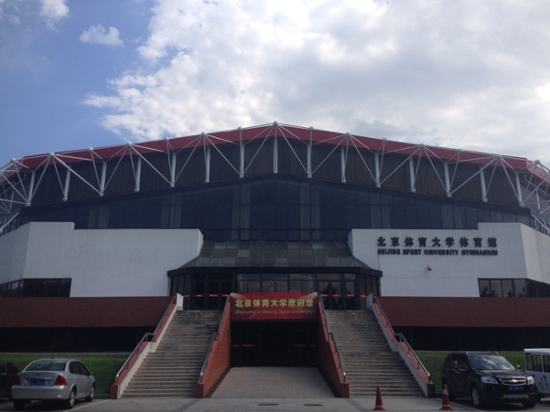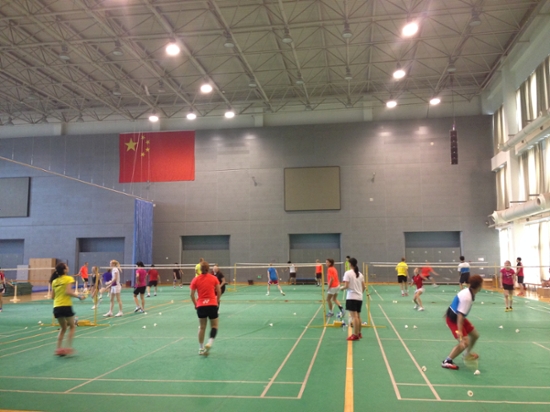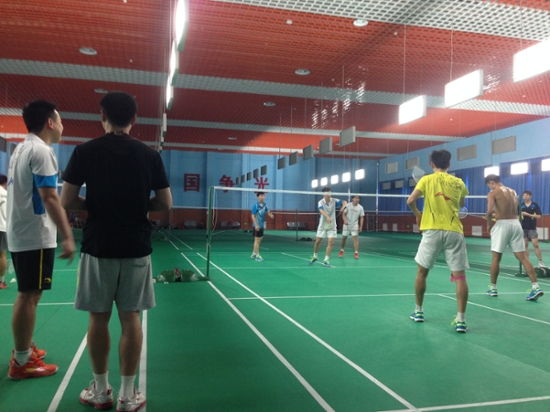“他们打比赛,你做步法” (“They'll play games, you do footwork.”)
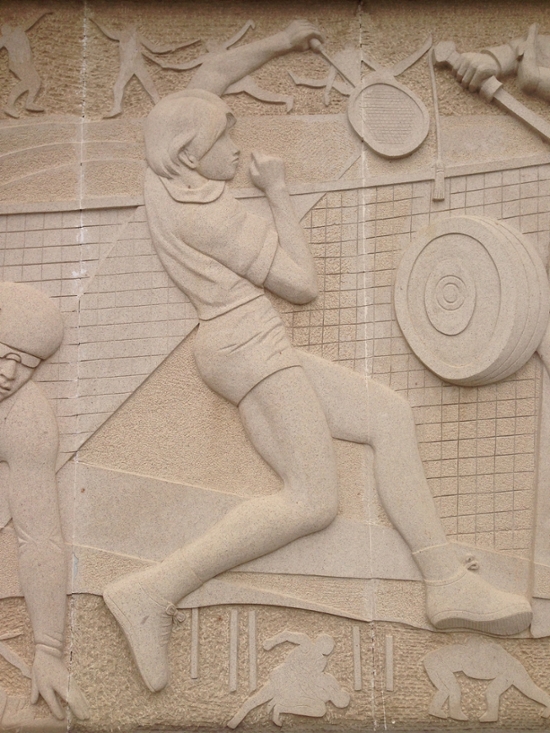
Those words more or less capture the story of my life for the past several weeks.
I am here at Beijing Sports University, staying in the international students dorm, waiting and writing as my clothes dry. I have no drying rack and the dorms have no dryers, so I've improvised a little bit with the curtain rods hanging around the window.
The room is nice. And the conspicuous absence of a dryer in these otherwise well-outfitted dorms is normal for Chinese colleges and households—where clothes hanging outside rooms is the rule and not the exception. You can bet that even if a Chinese person had a dryer, and all the money in the world to use it, many of those clothes would still be stubbornly hung up for Mother Nature to do her thing. Call it frugality mixed with convention, plus a dash of environmentalism 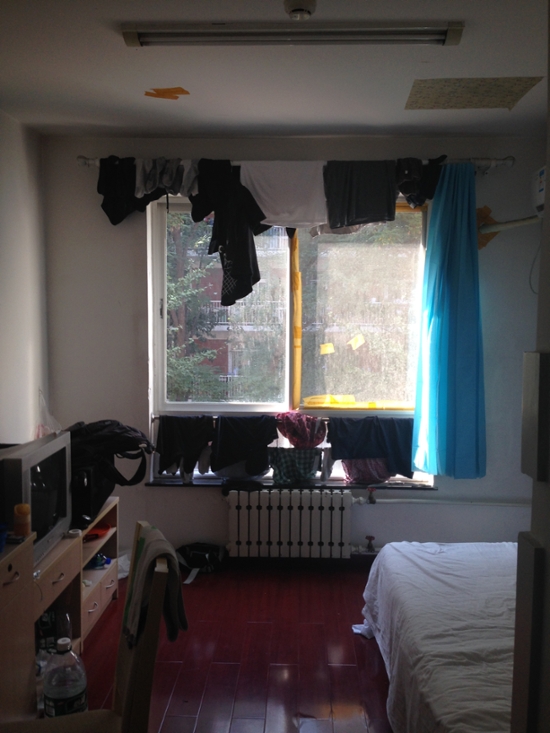
Through the window I see the red-brick, white-trim facade of the adjacent student dorm block. In a way almost reminiscent of Reed, these red bricks adorn most all of BSU's buildings, giving them dignified uniformity. But unlike our Eliot Hall's Gothic crown, these buildings are garnished with everything from Greco-Roman colonnades (a nice nod to the school's Olympic enthusiasm, I thought!), to elaborate futurist super-structures, to the traditional Chinese roof, with its signature corner-curl. 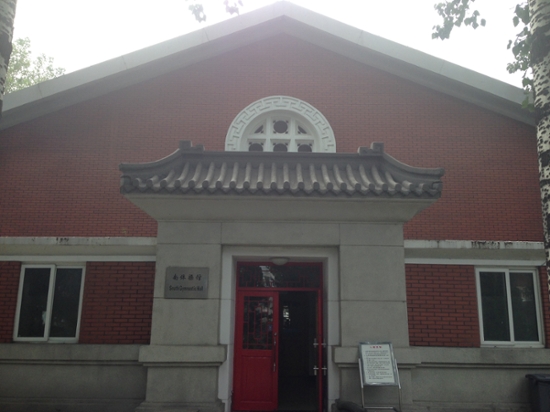
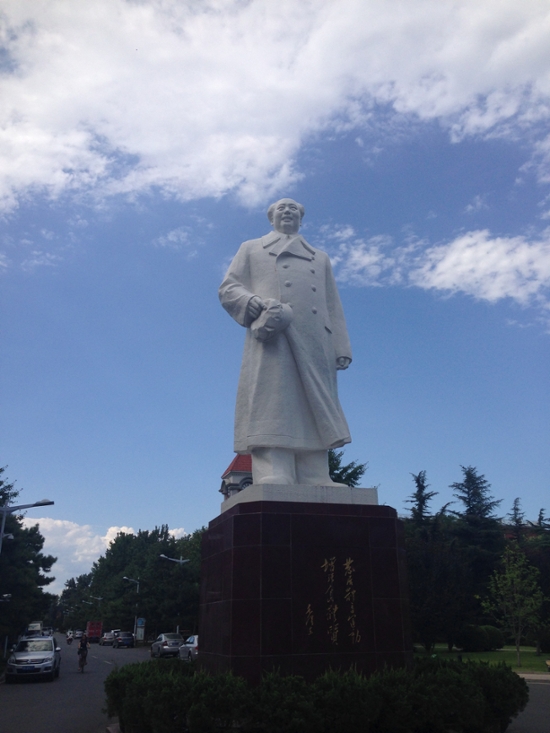
At Beijing Sports University, one may be a badminton major or a basketball major, but one may also major in sports science, sports medicine, sports education or sports management. It is as if China took serious athletic training, and all potential orbiting academic disciplines, and decided that they might as well coexist on the same campus grounds. The school is the best of a particular breed of Chinese university which, so far as I know, does not have a Western equivalent. Here athletes train as a part of a course load, but not to be national number ones, and scholars study, but not the same curriculum as their peers across the river at Beijing University. An oasis between widely separated amateur and professional worlds, this campus has been a great home base for my travels. Staying here I have met my present coach Teacher Zhou (or Zhou Laoshi, in Chinese), a dozen plus badminton majors, provincial badminton professionals, a very knowledgeable Danish badminton manager, and a batch of recreational Beijingers who play badminton damn well for having only picked up a racket a few months ago. Together, these individuals provide little windows into the broad landscape of Chinese sports, and broad insight into the particular world of Chinese badminton. My experience meeting, talking and training with them has been a story unto itself, and telling it here will, I hope, help illuminate a simple but remarkably expansive question: What challenges and opportunities does the badminton player, as an athlete in China, face?
Past the drying clothes, through the window and down the way lies the stately red-brick edifice of BSU's multipurpose gymnasium. That is where I myself began training just three weeks ago, and that is where I want to begin this story—on the hot, muggy walk from dorm to gym, my first day training at BSU.
It is summer time of course in Beijing, and as I walked to BSU's main gym that morning it was not just through a sauna, but a smoggy, badly filtered sauna. Summer indeed also meant that the students here, as at Reed, were mostly gone, returned home for summer vacation. It was a quiet walk through thick heat.
Beyond the weather, and the generally empty campus, my mind that morning was rife with mixed emotions and unsure expectations. I was still very much chaffing under my persistent wrist injury. The first day of training was just a day shy of the six week prescription my doctor in America had given me for wearing a heavy duty wrist brace. It was not the prospect of waiting another day or two to play that worried me, however. It was my own clear feeling that despite religious non-use, the wrist had not yet healed—perhaps was not even close to being healed—and that I might have to wait much longer than I or the doctor had anticipated. As I write these words, in fact, my old friend the brace is wrapped around my hand and wrist, bearing out that morning's feeling. And believe it or not, about one month ago I fell back in a chair and caught myself with my left wrist, injuring it as well. And while this injury is not as serious, surely it was a moment of sheer tragedy (perhaps comedy) when it became clear to me that even playing with my left hand (as I had started to enjoy towards the beginning of this summer) was simply too painful. So as I write these words, my old friend the right brace has been joined by a new friend, the left brace. I am, the way I see it, a walking fashion statement: Beijing's latest fad. I, in fact, sometimes do not tell strangers I am a badminton player when I meet them; I tell them I am a boxer.
Featherweight class.
This has been, in my own words, a tragedy of my inner badminton player, one that I have both laughed about and certainly cried about. You may ask why I signed up for summer training in the first place with such injures afoot. Well, it is true I assumed, perhaps optimistically, the wrist would be better by the time I arrived at BSU to start training. And I imagined that one way or the other being a short-term student here would bear fruit for my project, if not my racket skills (and it has). Finally, I happily attest that as a badminton player and an athlete, I know that there is certainly more to badminton than what you do with your racket and in games.
Hence the title of this blog.
So I was excited, one way or the other, to experience training at a top-level sports university, even if that training would be a little more lower-body oriented than I expected. I was eager to meet my new coach, and I was certainly eager to meet my fellow trainees—What was their skill level, and who, if not students, could they be?
When I arrived at Beijing Sports University's main gym, I found a dozen middle-aged recreational Beijing players, my coach, a helper of his from the pool of badminton majors, thick, unconditioned air, and five professional grade badminton courts. Immediately, and somewhat predictably, I was half-way between a sensation and—I mean this with all possible good will—a pet to the players there. I say sensation because the group was interested and enthusiastic about my training with them; I was after all not just a foreigner but an American, and the attitude towards our countrymen is usually one of pleasant surprise and warmth. I could speak some Mandarin—enough for basic introductions and enough to receive instruction. And I was obviously devoted to a sport which is a national pastime in China, but an afterthought in the States. My reception was thus safe and friendly, but the overall relationship somewhat confined. I could warm-up and stretch with them, but not play. I could speak, but not really converse. They were happy to feed me snacks and water, but also happy to talk about me amongst themselves in front of me. Thus I playfully employ the word 'pet' to capture myself as: a younger, more physical, fawned over, inarticulate and, because of my injury, limited member of this badminton family. Think of the dog invited to play Frisbee—I could reach the shuttlecock alright...but getting it back was a different story.
The coach, Teacher Zhou, understood the importance of letting my wrist heal uninterrupted, and was happy to take me through both conditioning and the delicate art of footwork. First, he got an idea of what I already knew. With him on one side of the court and myself on the other, Zhou Laoshi directed me to move to the four corners and shadow-hit the bird. His assessment was: basically right, but rough around the edges, and slow. Plus, the few minutes on court left me panting hard and sweating already. Thus one exercise outlined my training program for the next several weeks: foot technique, better speed, and hardened endurance. Now after several rounds of near-debilitating soreness—and a more sophisticated understanding of court mobility than I thought I'd ever know—I can say this training has been worth it in at least these respects.
As for my fellow trainees, I also got a good sense of how Teacher Zhou was taking these relative newcomers to the sport and transforming them into solid club-level players. Their improvement over these weeks has indeed been remarkable—one clearly sees the fruits of daily, two hour practice and a very experienced coach. Perhaps the most significant lesson here, however, is the fact that this batch of Beijingers has two hours a week to devote to serious badminton training. One consistent theme throughout my study into this subject is that badminton players are, we can say, generally not poor. The sport itself costs a surprising amount of money between shuttlecocks (used roughly at the rate one/game), equipment, gym fees and any lessons one chooses to take. Indeed, there is a great gap between the truly recreational players who play outside on occasion sans a net, and the group of players represented in my morning training session. Of the two groups the well-to-do Beijingers are the most vital to the sport. They are the middle to upper-middle class citizens who make up the sport's own solid middle class. These are the Chinese that know they need to be fit, but dread the gym. They want exercise to balance out a sedentary work-life, but also want to competitive and social. They want to see their skills improve in something, but don't want to get involved in a big team sport. They want to be gender inclusive—husbands playing with wives and girlfriends with boyfriends—which means other sports like basketball are generally ruled out. They want a sport they can play with their son, their spouse or their business associate, four times a week and twice on Sunday, and if you are Chinese, there is a very good chance that means you want to play badminton.
To touch on the question posed in my previous blog, badminton is indeed one of the most popular sport in China, but not because it gets the most views on television or the most fan attention. It is because groups like this play it more than virtually any other sport in China—more than basketball, soccer and even Ping Pong, so I've learned.
•
The following day, I went through another round of training in the morning, and was invited by Teacher Zhou to come see some higher-level training in the late afternoon. Surely this meant meeting the school's badminton majors. It was told they would be on campus and practicing for all of July in preparation for a nationwide tournament on August the 5th.
Famished as I was after my own training, I went to the school's cafeteria to have lunch and kill a few hours until their usual afternoon practice. Down at the old watering hole I could get a pretty good sense of the student body and let me tell you: I have never before seen more Chinese jocks in a single area. This is natural for a national sports training center. But it struck me as I saw the ensemble of cut gymnasts, towering basketball players and other assorted athletes that in a few key ways, I had made landfall at the big, sweaty, virile opposite of our own Reed College. Take the schools' attitude towards sports, or even more generally, body-culture. At Reed we have a horizontal body-culture. Our student body stretches itself out on the great lawn, uninhibited, careless, proudly variegated. To each person's body their own, we say. The jocks we do have are accepted as simply another feature of the body-scape—and a quite small feature at that. In this atmosphere, sports are taken as pure play. We may enjoy them, but it’s not a 10,000 seat-football-stadium kind of enjoyment. If anything we'll make fun of sport's serious treatment in mainstream culture. We make fun of it in part because behind those jokes is every Reedie's faith—however strong or weak— in something beyond the mortal frame: in the life of the mind. That is the joining thread, the pillar erected and worshiped in the middle of our motley community, and regardless of body-type or sport, everyone has some trace of that faith.
At BSU body-culture itself is the pillar, arranged vertically, not horizontally. It does not exist tangentially to the school's values; it dictates them. Fitness and athletic excellence are looked up to and saluted along side a big red flag. Here, the community celebrates 'the life of the body.' Here, there are a dozen gyms and halls dedicated to sports training, and one big teaching building (compared to our spread of teaching buildings and lone gym). Here the five Olympic rings adorn flower pots and sewage lids. And while it is true that about half of the students here focus on sports medicine or sports management—not a particular sport—these academic fields merely orbit the central athletic commitment: their curriculum is worldly, applied and practical. Nobody is taking Anthropology 324: Sport and Society (as you might have, if you were a Reedie last year). Nobody is philosophizing about sport's meaning in the culture; the meaning is consummate and the goals—excellence, expansion—clear as an Olympic swimming pool.
And the food, let me add, is not only supremely affordable but served in epic portions—how's that for opposites!
After eating, I took the short walk over to the school's devoted badminton gym. I heard the familiar *cracking* of shuttlecocks and slipping of shoes on grade-level courts, but upon entering I was taken with surprise:
Wait a second, these are white faces!
Apparently I was not the only one interested in BSU's strong commitment to athletics. Before me were 25 or so Danish youth badminton players and their coaches, outfitted and warming up for play. On the far side of the gym was more of what I was expecting to see: 12 or so Chinese badminton majors, casually slipping their gear on, talking amongst themselves. Two nations—one practice. Lord knows I would have loved to be the third nation represented, but being there with a pen was surely as rich an opportunity as being there as a player. These were Danes after all—the only Europeans to challenge Asian dominance in international badminton competition today. What better way to understand Chinese badminton than to run up against one of their most enthusiastic, yet culturally distant rivals? And see them practice together! Quite by chance, I had found a fantastic foil for my subject.
Chance indeed. Apparently this youth team is the only large group of foreign badminton players ever to come train in China. Examples of individual athletes seeking training abound, but a group like this is exceptional. The team comes only once every two years, and they happened to arrive a day before I did. Moreover, their team manager was nice, smart, spoke perfect English, and was himself working on a sports history master's thesis.
I had walked in looking for an afternoon snack, and found myself sitting at a wholesale banquet—in the next few hours my ears and eyes undoubtedly got their fill.
I made introductions with the badminton manager, Denis, and he said he'd be happy to answer any questions I had. In the interview tape I am listening to now, his voice has a slight Danish accent, and is punctuated by sounds and cries from the practice. Indeed the young Danes and badminton majors were warming-up together on courts just a few feet from our seats.
What is immediately interesting as I think of watching the practice and talking with Denis is that the two teams in front of us each represented a big step up from a group like the one I was training with (insofar as skill, physicality, investment in the sport), but by no means the biggest step up. This was a Danish youth team, but not the Danish Youth Team. The badminton majors, moreover, were simply not good enough to be professionals. In the great valley between the hobby world (epitomized by my training group) and the professional world, these teams had players who were just one foot out of the former, and players with just one foot reaching into latter. All had since leaped from recreational status. But most landed far short of the professional world; others landed in it but had already retreated. The youngest, most talented Danes were still mid-air: there was still a chance that in a few years they would land solidly on the national, or even international, stage.
This leap, or journey, is common to all serious athletes. But different individuals and cultures experience it differently. In understanding the particular expectations athletes set out with on their journeys—as well as the systems they are exposed to, pressures they are set under, and opportunities they are given for both achievement and retirement—we may get a unique window into not only their individual character, but the character of their surrounding culture and society. For the aspiring badminton athlete in Denmark is something quite different from the aspiring badminton athlete in China.
As a badminton player in Denmark, for instance, you would have been raised in a club setting, with club coaches, and club competitions. You would have undergone training in a club. Chances are your friends and social web would have centered around the clubs. The local club would have been a touchstone for your whole community.
As Denis explained to me, the reason behind this goes back over one hundred years, to when sports clubs and halls were first set up all across Denmark. At that time, ladies would play handball in the summer, and guys would of course play soccer. Everyone would do gymnastics in the winter. When badminton was introduced in Denmark around 1925, it just so happened that the typical sports halls at that time fit a good five or six courts. Installation was cheap and easy, and people—for whatever reason—took to the sport. It caught on like wildfire. Today, whether you play in a little town of 800—like Denis did when he was growing up—or a big city, clubs are still very much the focus of your badminton life.
But even though there is a sports hall in virtually every town and city in Denmark, the number of badminton players in total is still relatively small. There are only about 100,000 registered players. The nation itself is quite small to be competing in international tournaments. So, in Denis' words, coaches like himself “focus a lot on the individual player. We nurse them, we care for them and all of that, we really take care of our talent because we just don't have that many.”
He explained that it becomes particularly difficult to hold onto players around the ages 16 and 17 when training really begins to emphasize physical conditioning. This is also exactly when academic and social pressures begin to ramp up, and young players realize the sacrifices incumbent in their play. So Danish coaches take pains to forge a strong rapport between themselves and their students, hone their particular strengths and encourage them to stick it out for the long game.
If the problem in Denmark is too small a pool of players, however, then the problem in China is there is too big a pool. The nation flourishes in China's sheer numbers, but individuals drown. To be a professional in China is to climb a highly competitive hierarchy organized and funded directly by the government. You enroll in a county sports school, then progress to a municipal sports school, municipal sports team, provincial team, and finally national team, at each juncture praying to survive a rigorous selection process from coaches. Clubs are also quite popular in China, but they are radically divorced from the professional track. In fact, there aren't any nominally professional clubs in China, and virtually no provincial or national players come from clubs. If you want any shot at a professional career, you have to start in a sports school.
Coaches in China have a standardized, detailed syllabus that has been developed over years by badminton professors like Dai Jinbiao and Zhou Laoshi. It outlines exactly what students should be learning and training for at what age. There is a standard, and players are held strictly to it, which means their technique is excellent and uniform. “There is no hocus pocus with what they do,” as Denis put it. “It's very, very simple actually.”
Because of the great pool of players and extremely standardized system, we may say that basically, the ball (or bird) in China is in the coach's court, not the player's. The coach has final and complete say over who makes it and who doesn't. As Denis emphasized, the coaches are under less pressure to form an egalitarian rapport with their players, or hone individual talent according to anything outside of the standard. From his perspective, this is a point of wry optimism: “Hopefully the Chinese will never start doing what we do,” he joked, “or we're fucked....” To Denis, the only reason Denmark has been able to hold its own in international play is because of its focus on the individual. In his view, the Chinese approach accounts for their players' incredible success, but also entails their ultimate limitations. “We're a lot smarter [with the talent we do have], that's what we believe in, and we have to believe in it,” he said.
Regardless if Denis is correct in his diagnosis of Chinese training, the culture gap between the two groups came to the fore during a telling moment in practice. 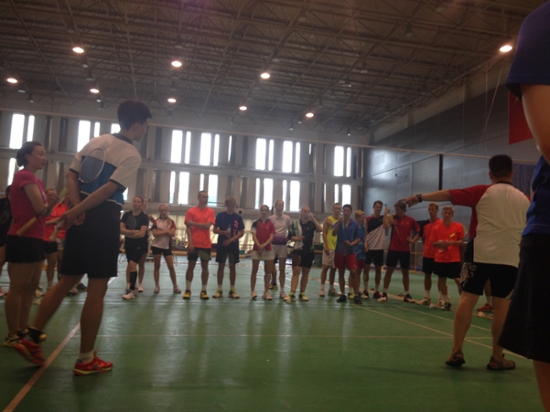
If we extrapolate this phenomenon to China's overall system, it is easy to see that as the nation squeezes a big batch of players to produce an Olympic diamond, most players slip through the cracks. If a player does not make it past a particular threshold of selection, or if they get badly injured, that may simply spell the end for their badminton career. In this analysis, making it as a provincial player is the deal breaker for Chinese badminton players. Even if your skill is incredibly high relative to other countries and players, if you aren't accepted to a provincial team in your early teens then your chances at a professional career are virtually nil.
For all those Chinese players who fall short of the mark, but still love badminton and want to make something of their investment, I am glad to see that schools like BSU are offering solid alternatives. Most of the badminton majors playing in front of Denis and I had been playing for several years before coming to BSU.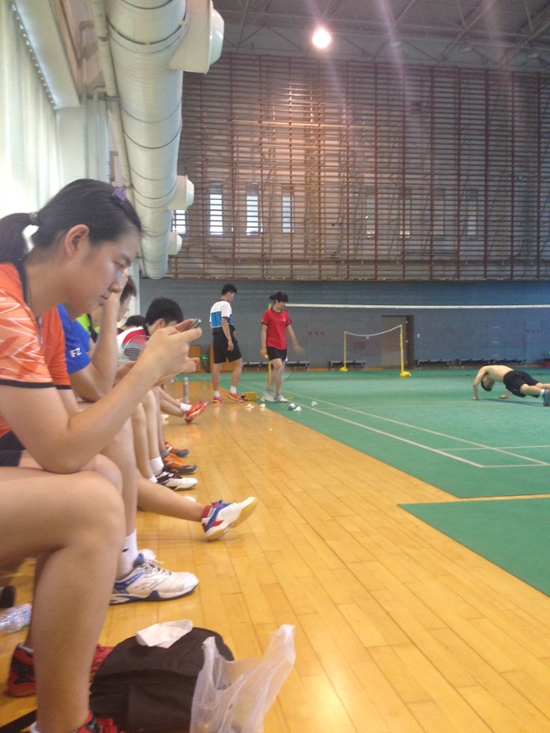
The terminal station on the Danish side of things is a little harder to speak for. The lines separating badminton as a career and badminton as a hobby in Denmark are less clear in the first place. Most of the Danes who came to BSU are what Denis calls “good divisional players”: they do well and have fun in Danish League play, but not much more than that. The better of them will pick up a tournament prize or two, or manage to get small sponsorships. Once this youth group graduates high school, many will pursue their passion in badminton while working on the side or going to school (universities in Denmark, after all, pay you to take classes). Maybe half the players will end up teaching badminton. Regardless of the ebb and flow of their commitment, however, these Danes will always have the same place to play in, the static home of their badminton life: local clubs.
•
Danish or Chinese, club or sports school, I must say that the skill on display before Denis and I was simply amazing; I sat in awe and envy. Against a 16 year old Dane, I would be happy to get 12 points out of 21 (with a healthy right wrist, of course) ; against a badminton major, 6. It was hard to imagine that the very best of the players in front of us would himself likely get only 10 points against a provincial professional.
For the young Danes, these bi-annual trips to China are a great opportunity to both travel and get exposed to different players and styles. And the meeting itself represents a very healthy relationship between these two countries' badminton worlds. Even though Denis joked with me that the Danes come because they “want to confirm their prejudices about the Chinese way of training,” in truth he and the other coaches are eager to learn as much as they can from the Chinese coaches. They ask for very normal, practical Chinese training of ground strokes, and the Chinese coaches themselves take notes on the way the Danes train. I was both surprised and heartened to hear that there do not seem to be any guarded secrets regarding training or racket techniques. If Danish coach asks, the Chinese coach will be happy to answer, and vice-versa. Both parties are before all else interested in growing the sport.
Towards the end of practice, Denis pointed out to me that fatigue was beginning to show on his players. The heat was getting to them, they had been training for several days in a row, and their “free time” was spent making trips to the Great Wall. But they seemed happy. When these trips first began seven years ago, the two country/one practice sessions could be awkward for players. English was a shaky common language. There was an age gap. But now both groups know what to expect, and look forward to the meeting all year. An intimacy that wouldn't have appeared until the very last day seven years ago now flourished on the third day.
Players were slapping each other on the back, hooting, playfully admonishing and approving one another as a final round of games wrapped up the practice.
•
In the next few weeks I continued to train in the morning, and would check out the badminton majors in the afternoon. The Danes left at the end of that first week. On their last day of training, an informal “meet” was held between the two groups, but the young Danes were woefully outmatched compared to the 20-something year old colleges majors. The games were great entertainment though. I settled down with the coaches in the back and ate snacks, watching. When the matches were all finished, we bade goodbye to the Danes and I thanked Denis again for all his input. He told me that maybe we'd see each other again in two years.
•
One day in the second week, Teacher Zhou took me to the side at the end of morning practice and said he had a proposition for me. He knew about my interest in Chinese badminton culture, and told me that next weekend he'd be taking a trip to visit a provincial team in Shandong. “You'll pay for your own ticket of course,” he said, “but if you'd like we can go together.”
A trip like that would be a once in a lifetime opportunity—there's no way I could say no. I had trained with amateurs, fraternized with good divisional players and badminton majors, but I had yet to see true professionals (unless you count the hundreds of collective hours I've spent watching badminton on TV).
Zhou and I were only gone for a few days. He ended up leaving a day early, so I went by myself and met him there. I arrived in the coastal city of Qingdao on a Friday night, and Teacher Zhou had a driver come pick me up from the train station.
From the moment I met Teacher Zhou that Friday evening, the trip had a surreal, how did I end up here? sort of quality that make for the best travel experiences. I did end up meeting some pretty incredible players that weekend. But half the interest of the trip was not so much the players, but the powerful officials, coaches and friends of Teacher Zhou that work behind the scenes, administering the players. These officials, of course, are just as necessary to China's continuing dominance in badminton as those who actually wield the racket.
It turns out they are basically like other Chinese businessmen, I guess.
That night, the driver dropped me off at a fancy, beach side restaurant, and Zhou Laoshi came down to fetch me. He was having dinner on the ocean-facing deck. It was too dark and foggy to see the sea, but you could hear it, and smell it. Five well-dressed Chinese men around Zhou's age were sitting, drinking, smoking, and talking over a table of well-eaten food.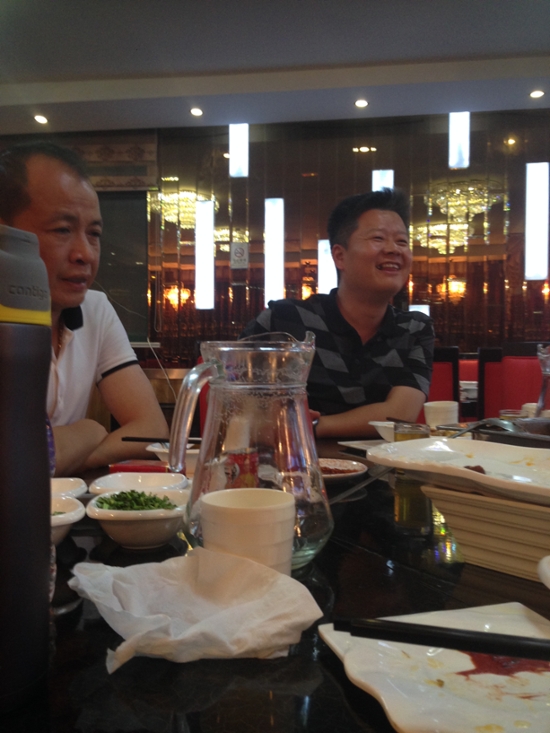
Dinner that first night was by no means the last of such...business meetings. The more long, expensive lunches and dinners we had, the more I began to get the hang of such affairs. For they undoubtedly had an underlying script and ritual. This is what Chinese businessmen do, at least in this part of China. It begins in a nice restaurant, and ends three or four hours later in a mix of drunken good feelings, and sealed business deals. During the dinner, the most significant gesture is the toast. No one takes a single drink except during a toast. You can toast the group, or you can toast an individual or a few people. Just like toasting anywhere else, you toast to some shared experience, memory or agreement. If you toast to a certain person's virtues, giving him a compliment, that person is expected to toast back some time. If someone of a higher class or age toasts you, you are expected to clink your glass below their glass. If the toaster drains their cup, you are expected to drain your cup.
I won't say I learned all of this the hard way, because there were no real consequences for me making a fool of myself midst such unspoken rules. I'm a foreigner—they understand. By the third day though, I had it more or less figured out.
When I related my experience to Dingyi, she duly pointed out that this is one of the only opportunities for Chinese men “to get all their feelings out.” It's true. And it works. I had a touching moment myself when one night I ventured a toast to Zhou Laoshi, thanking him for all his help and good will. He responded that he also admired me, and that he was happy to be traveling and getting to know me.
As a side note, I might as well say that of all the individuals I've met at BSU—and certainly during that trip—Teacher Zhou was one of the ones I liked the most. He, like the other well-to-do Chinese businessmen, was pretty crude to his body, drinking heavily and chain-smoking. He ate ravenously, and had put on quite a few pounds since his own playing days. But his demeanor towards others was always amiable, direct and insightful. Certainly, as his student, I can say his coaching sensibilities were acute and his knowledge of the game remarkably deep. Even outside of badminton, though, he came off as a curious and thinking fellow; with me and others he was always asking questions, surmising characters and situations. He had a good sense of humor, and at times let show a child-like playfulness. He was very patient with my Mandarin, and genuinely believed that the travel we were undertaking, and the different levels of play I was being exposed to, would do myself and my project good. He, after all, had set the trip up.
Speaking of different levels of play—what of the Shandong provincial team? They were the reason I had left Beijing the first place. Who were those precious few who had made the grade, met the standard, and now played for their own country and livelihood?
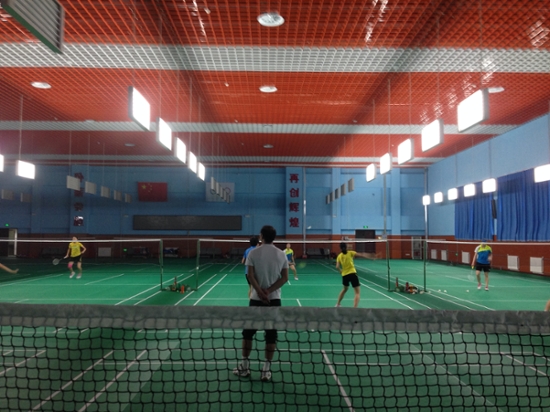
On court, their movements and shots were, in a word, crisp. They played just as the badminton majors did—same technique, same shot range—but the pace of everything was notched up a few degrees. They were a sleeker model, with a bigger gas tank. They had an extra gear they could shift into. Each smash, drop, drive, clear had an ease and precision which naught but years of dedicated training could produce.
In talking a bit with the players and coaches, I learned that the team trains three hours in the morning, three hours in the afternoon, Monday through Saturday. Sundays they have off, and Saturdays require only the morning session. Insofar as expenses and salaries, all room, board and equipment fees are taken care of. Each player also gets a monthly stipend of about 3000RMB, or $500, (close to the average salary in Shandong) to spend as they please—this amount may be more or less depending on the individual's skill level and match record.
Zhou Laoshi and I had lunch at the training center and toured the facilities a bit. The food was excellent, and the dorms, though three persons a room, spacious and pleasant.
All in all, I can say that the life of the provincial professional seems comfy and gratifying, though hardly extravagant. Extravagance, of course, is not why they are here. Even those Chinese who make it onto the National Team and compete in international tournaments are not possibly expecting to get rich, or have a lavish retirement. The bonuses of one successful tennis professional are more than the bonuses of all badminton players in the world, so Professor Dai told me. There is little fame or fan attention in the sport, unless you are one of the true handful of badminton stars. The Chinese badminton cream of the crop have had to work very hard to be among the elite, but their reasons can be summarized under social duty and camaraderie, love of country, and of course simple love of the sport.
•
I now sit at the end of a month at BSU. The morning training program with the amateur Beijingers lasted only a month, and has since drawn to a close. And the badminton majors' tournament, which I am looking forward to spectating, is only a day away. After that, they will stop training, and I will have left BSU.
I, personally, cannot help but idealize and admire many of the players I have met this month, the really skilled ones. They play like water running over smooth rocks. Their skill is tactile and irresistible. It is a pity I've been unable to train my racket technique in the past several weeks (foot technique, happily, is a different story). When these braces come off, I will be eager to get back on court myself—but it seems I will have to wait until I am already back at Reed for that. It turns out travel is not exactly conducive to the wrists' healing. In the meantime, I am a boxer to all those who ask about my curious garment.
Featherweight class.
My love and thanks,
Chris Stasse
Beijing, China
5 August 201

